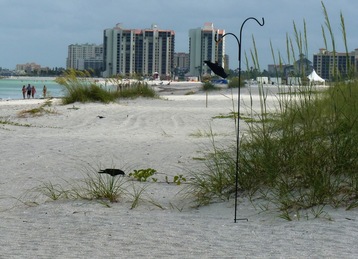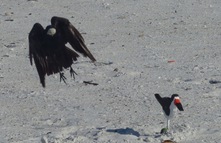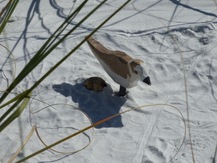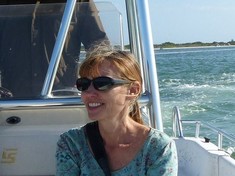|
Having trouble viewing this newsletter? View it as a web page.
Welcome to the Spring edition of Living on the Edge, the newsletter of the Coastal Wildlife Conservation Initiative! This is a quarterly newsletter to update Florida Fish and Wildlife Conservation Commission (FWC) staff, partners and members of the public interested in Florida’s coastal issues about current projects and other points of interest. Regular highlights will include featured projects related to coastal wildlife, interviews with our staff or partners, special seasonal considerations, news and events, and current funding opportunities. If you are interested in spreading the word about your project or someone who is doing a fantastic job in coastal conservation, please contact the CWCI Coordinator, Fara Ilami, at fara.ilami@myfwc.com.
The Coastal Wildlife Conservation Initiative is an FWC-led multi-agency strategy to address threats to coastal wildlife and habitats, while considering human interests and uses of Florida’s coastal areas. The goal is a statewide, cooperative process to protect coastal wildlife populations, conserve and manage coastal ecosystems, and achieve balance between conservation and opportunities for recreation, commercial activities and responsible development.

April 22 is Earth Day,
and this year there are more ways to participate than ever. From mangrove
plantings and coastal
clean-ups to Ecofests
and more, everyone can find a way to make their conservation mark. There is
even a lionfish
derby for those who want to fight invasive species. For more information
about events in your area, check with local news outlets or Eventbrite.
In addition, Earth Day is the perfect time to make or renew long-term
commitments to conservation, such as using less plastic, recycling, reducing
your carbon footprint and eating less meat. If you would like to take action to
conserve coastal wildlife and habitat as part of your Earth Day pledge, contact
the CWCI Coordinator for ideas and
opportunities.
Back to Top
|

In
Southwest Florida, shorebirds and seabirds have had relatively
low productivity. This is due, in part, to predation of their eggs and
young by fish crows. The fish crow's diet is highly variable but includes
a large proportion of marine and other invertebrates, carrion, bird eggs,
berries, fruit and seeds. Dr. Beth Forys, Professor of
Biology at Eckerd College, has been trying to
find an effective way to deter crows from predating shorebird and seabird nests.
Dr.
Forys considered using a number of techniques. Lethal control of fish crows was
considered but rejected, due to the difficulty of implementing it on urban
beaches, ethical reasons, expense and concerns that crows from neighboring
territories would simply move into the vacated territory.
Non-lethal
methods also were explored. Dr. Forys first attempted to replicate
experiments that had been used successfully with other crow species employing
effigies (dead crows) to scare the fish crows away from a black skimmer colony. This
was not successful, most likely because of the fish crows’ high intelligence
level and the fact that effigies were placed after the onset of the black
skimmer breeding season (previous studies had demonstrated success with
effigies erected before crows had eaten many eggs).

Last
year a new method was tried — Conditioned Taste Aversion. CTA involves the use of
emetic eggs (eggs injected with a substance which will make crows quickly
vomit, but does not harm them) in order to teach the crows to avoid
eggs. CTA has been used successfully in other areas when deployed before
the onset of shorebird nesting. This study was trying to determine if egg
predation could be decreased once shorebird nesting begins. Results showed that
areas where the emetic eggs were used had fewer real eggs taken by crows.
However, the cost and complexity of getting the chemical licensed in the state
for large-scale use is prohibitive.
|

This year Forys and
her team are trying to re-educate the
crows by using electrified eggs placed in nest scrapes and accompanied by
decoys. When a crow tries to grab or peck one of the treated eggs,
it gets a mild shock that appears to startle the unsuspecting birds. Preliminary
results indicate that the crows quickly learn to avoid the decoys and
eggs. The crows’ response to the mild shock appears to be one of
surprise
followed by a healthy suspicion of the nests and eggs. The study will be
replicated at five additional sites. Researchers will continue to monitor fake
nests as well as real ones at these sites to see how long the effects last and
crows remain wary of shorebird nests. Results from this study will be reported
in The Wrackline, the newsletter of the
Florida Shorebird Alliance.
Photographs courtesy of Dr. Beth Forys
Back to Top
|

Spring begins the annual influx of people recreating on
Florida’s beaches, and this coincides with breeding season for many species of
coastal wildlife. Many endangered or threatened coastal species are subject to
predation by other wildlife such as ghost crabs, crows, laughing gulls,
raccoons, foxes and coyotes. Even domesticated dogs and cats can be potential
predators.
The risk of predation is high for eggs or defenseless young,
and it grows even higher when trash and other predator attractants are present
on or near the beach. For example, raccoons are often found rummaging through
trash cans for food scraps. If trash
cans are on the beach near a nesting area, raccoons could more easily find
shorebird eggs. Crows and gulls also frequent areas where picnickers leave food
scraps at the beach, and both will take shorebird eggs and young. Outdoor housecats and feral cats can eat
beach mice and birds. Dogs that are not on a leash can dig up and eat sea
turtle eggs. Some predation is natural, with ghost crabs, for example, being
major predators of shorebird eggs.
However, it is important to realize that human food sources
effect coastal predators in two ways. First, food sources such as trash cans
routinely attract predators to areas where they otherwise only may have gone
occasionally. Secondly, regular
availability of human food over time can cause predator populations to become
higher than they would be otherwise, because more available food means they can
reproduce more successfully.
Help prevent human-subsidized predation on the coast:
- Throw away all trash in covered containers or –
better yet – pack it out and dispose of it away from the beach (for example, at
home). Trash includes food leftovers and packaging, charcoal, fish scraps and
pet waste.
- Do not leave food out for feral cats or other
animals. If you must feed your pets outside, promptly remove bowls and other
materials associated with food when they are done eating.
- Do not walk your dog where it may present a disturbance
or threat to wildlife — this includes designated Critical Wildlife Areas, roped
or flagged areas, dunes and anywhere that shorebirds are present.
- Keep your dog as far away from wildlife as
possible. Do not allow a dog to disturb or chase birds or dig near turtle
nests.
- Avoid walking your dog on the beach at night
during the March-October sea turtle nesting season.
Back to Top
|

1. What is your title? Professor of Environmental Science & Biology
2. What organization do you work for? Eckerd College, St. Petersburg, FL
3. What type of work do you do? I am a professor who teaches Conservation Biology, GIS and Ornithology at a liberal arts college. In addition, I do research on shore/seabird conservation.
4. What projects have you recently been working on? Since 2009 I have been banding least terns and black skimmers in Pinellas County (working with master bander Marianne Korosy - Audubon Florida). This data is being used to measure survivorship and movements of these imperiled species. In addition, I've also been doing research to determine the best method of discouraging fish crows from taking shorebird and seabird eggs (see “Featured Project” for more information).
5. How does your work relate to the CWCI? We are trying to protect coastal wildlife populations.
6. How long have you been working in the coastal environment, and what are some lessons you have learned? I have been doing research in coastal environments for 29 years. One important lesson that I have learned is that while it is very important to protect more pristine areas, more human-impacted areas can also play a role in conservation of coastal ecosystems and populations. I have seen populations of shore and seabirds thrive even in urbanized areas, provided we have a strong public education component, enforcement and predator management. These species enhance the experience of beach visitors because they are beautiful and interesting to watch.
7. What do you think is the greatest threat to coastal ecosystems, and what action(s) should be undertaken to address it? The two greatest threats that I've experienced:
- Global environmental change has resulted in sea-level rise and an increase in storm frequency and intensity. This has led to an increase in over-wash events of shore and seabird nests, often resulting in mortality of eggs and chicks. I'm not sure how to address this at a local level, but clearly steps need to be taken to decrease greenhouse gases at a global scale.
- Increase in human activity on beaches impacts shore and seabirds in terms of direct disturbance of the birds and an increase in native and nonnative predators. When people get too close to bird nests, they often scare the adults off the nests, leaving the eggs and young susceptible to predation and overheating. Human trash increases predators. Environmental education through various methods (including bird steward) is helpful to protect nests and colonies. Working with local municipalities and law enforcement on trash removal and citing people for having fireworks and dogs is also key.
8. What is your favorite coastal animal, and why? I honestly do not have a favorite animal. I've been fascinated by every species I've studied, so I'm the perfect person to study species that need help, but are not getting much attention.
9. Do you have a message you would like to share with readers of this newsletter? I would like to mention that none of the conservation or research I've done would be possible without amazing volunteers and partnerships with nonprofits, county, state and federal biologists and managers. I think the integrative approach that the CWCI takes is the best way to protect our valuable coastal ecosystems.
|

Florida’s coastal areas are world renowned and attract
millions of visitors each year. These habitats and Florida’s moderate climate
provide numerous recreational opportunities, including boating and fishing,
hiking, wildlife viewing or just soaking up the sun on the state’s beautiful
beaches. These pleasant activities can be painfully interrupted by one of
Florida’s most ubiquitous but unseen denizens, the no-see-um.
Also known as biting midges or sandflies, these flies, relatives of mosquitoes,
are often felt but not seen. They leave their victims with painful and
irritating bites, which can lead to long-lasting wounds.
Florida is home to more than 47 species of biting
midges, mostly in the genus Culicoides
(Insecta: Diptera: Ceratopogonidae). Salt marshes and mangroves are major
habitats for no-see-ums in Florida, although they can also utilize areas with
wet, organic soils that are not inundated. For this reason, biting midges are
often associated with livestock operations.
|

As their name implies, no-see-ums are very small, usually less than
1/8th of an inch long. They have a relatively short reproductive cycle of
between two to six weeks from egg to larva to pupa to adult. Biting midges
utilize anautogenous reproduction, which means females require a meal of blood
to begin their reproductive cycle. Only females have a proboscis (elongated
mouthpart) that is adapted for blood-sucking. The number of eggs produced,
usually between 50 and 110, depends on the species and the size of their last
blood meal. Larvae are not aquatic but require moisture for development.
Through their blood-sucking, no-see-ums are sometimes
vectors for disease-causing organisms, including filarial worms and viruses.
The pain and itching associated with no-see-um bites are an allergic reaction
to proteins in the fly’s saliva. Topical antihistamines may bring some relief,
but the reaction may last as long as a week.
The University of Florida’s Institute
for Food and Agricultural Sciences recommends installation of screens with
smaller mesh for windows and patios to exclude no-see-ums and avoid the painful
effects of their bites. Due to their small size, midges can pass through
standard mesh “mosquito” screening. Additionally, fans can help deter
no-see-ums, which are weak fliers. Most repellents for flies and mosquitoes
also work well for no-see-ums and should be applied before outdoor activities,
but one should always follow the directions on the label.
For more information on these seldom seen but often felt
members of Florida’s fauna, please visit the following sites:
http://entnemdept.ufl.edu/creatures/aquatic/biting_midges.htm
http://freshfromflorida.s3.amazonaws.com/arthropods-of-florida-vol-10.pdf
Photograph courtesy of Dr. Roxanne Connelly, Florida Medical Entomology Laboratory, University of Florida
|
NRCS Regional Conservation Partnership Program
— RCPP will make awards to locally driven, public-private partnerships that
improve the nation’s water quality, combat drought, enhance soil health,
support wildlife habitat and protect agricultural viability. The deadline is April 21, 2017.
J.M. Kaplan Fund J.M.K. Innovation Prize — The Prize
seeks to support innovation in the fields of the environment, heritage
conservation and social justice. Non-profit organizations and mission-driven
for-profits organizations are eligible. The deadline is April 28, 2017.
NPS Land and Water Conservation Fund State and Local Assistance Program
— The National Park Service provides matching grants to states and through
states to local governments for the acquisition and development of lands and
waters for outdoor recreation purposes. Search grants.gov for P17AS00112.
Applications must have been reviewed and cleared by NPS for final submission by
the deadline, April 28, 2017.
The Lawrence Foundation Grants —
The foundation is focused on making grants to support environmental, human
services and other causes. The foundation makes grants to U.S.-based qualified
charitable organizations. Applications are due April 30, 2017.
Conservation Alliance — Seeks to protect threatened wild
places throughout North America for their habitat and recreational values. Accepts
grant applications from non-profit organizations with a focus on protection of
a specific wild land or waterway, engaging grassroots citizen action in support
of the conservation effort, and demonstrating a clear recreational benefit.
Organizations must be nominated before applying for grant requests. Nominations
are due by May 1, 2017 and proposals
are due June 1, 2017.
NAS Gulf Research Program Research-Practice
Grants — Research-practice
grants aim to advance science and its application by (1) accelerating knowledge
transfer from researchers to practitioners, thereby facilitating
implementation; and/or (2) encouraging the use of practitioners’ knowledge and
lessons learned from experience to inform research. Proposed projects must be
hypothesis-driven and seek to improve science and practice by bringing together
researchers, practitioners, or other relevant perspectives. Mandatory letter of
intent is due May 3, 2017. Full
proposals are due June 28, 2017.
U.S. Fish and
Wildlife Service 2017 National Fish Habitat Action Plan — Projects should support national and
regional science and coordination activities to protect, restore or enhance
fish habitats. Applications are accepted on a rolling basis through May 31, 2017.
U.S. Fish and Wildlife
Service National Coastal Wetlands Conservation
Grants — Awards are to protect, restore and enhance coastal wetland
ecosystems and associated uplands. The grants are funded through the Sport Fish
Restoration and Boating Trust Fund, which is supported by excise taxes on
fishing equipment and motorboat fuel. Search grants.gov for F17AS00108. The
deadline is June 30, 2017.
Northrup Grumman — Supports
communities, projects and organizations, particularly where its employees live
and work, with financial, in-kind and volunteer resources. Grants are awarded
to accredited schools and 501(c)(3) nonprofit organizations for projects
focused on education and the environment, among others. Requests for funding
will be accepted beginning February 1, 2017 through June 30, 2017.
U.S. Fish and
Wildlife Service North American Wetlands Conservation Act
Standard Grants — Public-private matching grants support long-term
protection, restoration and/or enhancement of wetlands and associated upland
habitats. U.S. Standard Grants Cycle 2 applications are due July 14, 2017. U.S. small grants
applications are due October 19, 2017.
Rockefeller Family Fund — Grant
making currently has an environment program focus on the challenges of climate
change with an emphasis on public education. Letters of inquiry (LOI) may be
submitted at any time.
Surdna Foundation Grantmaking — Grant making to nonprofit
organizations in the priority areas of Sustainable Environments, Strong Local
Economies and Thriving Cultures. Letters of inquiry (LOI) may be submitted at
any time.
Waitt Foundation Rapid Ocean Conservation
(ROC) Grants — This opportunity provides small grants with a quick
turnaround time for solutions to emerging conservation issues. The funding
cycle is open to new applications. Proposals are reviewed monthly on a rolling
basis, although some application take additional time to evaluate.
Wells Fargo Environmental Grant Program
— Environmental grant program focuses on addressing local environmental
priorities in communities and providing support that fosters innovation to help
accelerate a “green” economy. One letter of inquiry per year per organization
is accepted.
|